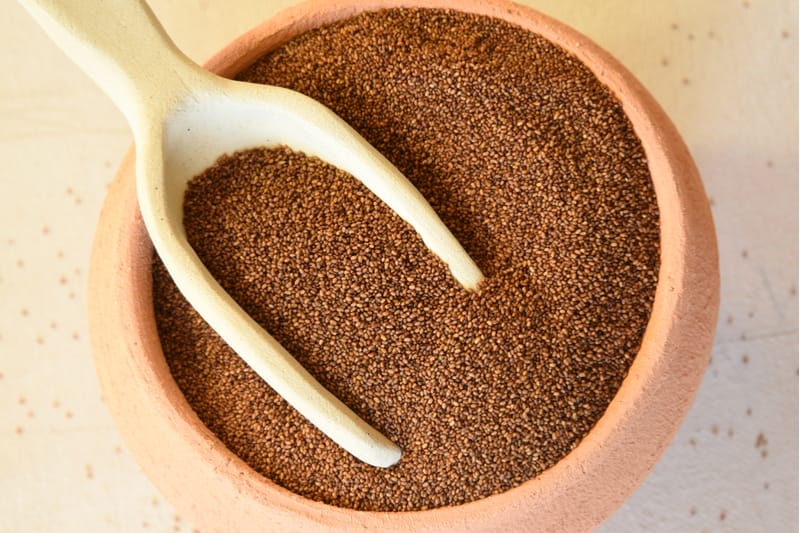
Want to know more? Read on to further acquaint yourself with teff, , and learn how to begin incorporating it into your daily diet.
What Makes Teff SpecialTeff can be grown in virtually any climate and produces an impressively of purple, gray, red, or yellowish brown crops. In fact, to sow a typical field is a handful of teff, and once you have your seeds (which range from dark reddish brown to yellowish brown to ivory in color), teff cooks quickly (it requires to sprout, which is the shortest time of any grain) and uses less fuel than other foods.
Teff is the only (or seed) that contains vitamin C, and is both gluten and grain-free, making it an allergy-friendly source of nutrition for many folks.
Teff’s Nutritional Benefits
 /Shutterstock
/Shutterstock
Want a more in-depth analysis of teff’s nutritional benefits? Allow us to break it down. Per 50-gram dry serving, 20 percent of your daily recommended dietary allowance (RDA) of iron, 10 percent of your RDA of calcium, 7-grams of protein, 4-grams of fiber, and trace minerals of phosphorus, magnesium, and manganese.
That’s not all. Teff is also known to , boost immunity, stimulate digestion, strengthen bones, promote cardiovascular health and aid weight loss.
Where to Purchase Teff (And What Kind)
 /Shutterstock
/Shutterstock
Teff can be found online at most retailers that sell grains, but if you’re not a big fan of virtual shopping, you should also be able to find teff in health food stores nationwide.
White or ivory teff has the mildest flavor, while the darker varieties provide a more earthy taste. Remember: if you’ve only ever tasted teff in , which is an Ethiopian sourdough flatbread that is used as an edible serving device to sop up lots of delicious Ethiopian stews and condiments, you might assume it only tastes sour — but that’s not the case. When teff is not fermented, it has a sweet and light flavor.
How to Cook Teff
 /Shutterstock
/Shutterstock
Cooking teff is a simple and fast undertaking. All you need to do is boil some water on your stovetop with a pinch of salt, making sure to use a 3:1 ratio of water (or ) to your teff grain. Once your water reaches a boil, reduce to medium heat, add your teff, and stir your mixture slightly. Then, cook your teff on medium heat for around 15-20 minutes. Once your teff grain has absorbed most of the liquid and softens, you’ll want to turn off your stove and move your pot from the heat source. Put your lid on your pot in order to let your teff grains steam up for about 5-minutes, until it sets.Consume right away since teff can become soggy or too thick (like oatmeal does) if left sitting for too long. It should be soft and creamy, with even a little wiggle room to add more non-dairy milk if you like (for extra creaminess, of course.)
Remember: you want to consume your teff right away because it can actually thicken up too much or become either soggy (sort of the way oatmeal does) if you leave it sitting out for too long.It should be soft and creamy, with even a little wiggle room to add more non-dairy milk if you like (for extra creaminess, of course.)
You know you’ve cooked your teff properly if you’ve achieved a soft and creamy texture. If you’re into extra-creamy teff, feel free to add a splash more of some plant-based milk.
If you have a slow-cooker, you can use the same 3:1 liquid-to-teff ratio, and cook your teff on high for an hour, or on low for two hours.
Use Teff in Your Home Cooking
There are so many different ancient grains out there, it can be a little daunting trying to figure out how to incorporate new ones into your daily diet with ease. Luckily, our is here to help. It’s extremely easy to swap teff in for many staple ingredients you already have in your pantry (and many products you buy could actually already be !).
For instance, did you know teff can take the place of quinoa and granola in many recipes? Try making this for a warming morning meal, or cook up a healing batch of this for breakfast.
You can grind and use it for an assortment of different purposes. Teff is an essential ingredient in injera (and we suggest dipping your injera in one or all of these ) but you could also use teff flour to make or these gluten-free .
If you’re interested in reading more about , or even learning how to make with them, then we highly recommend downloading our , which is available for both and , and can also be found on and . The app has more than 8,000 plant-based, allergy-friendly recipes, and subscribers gain access to ten new recipes per day. Check it out!
Lead image source: /Shutterstock
